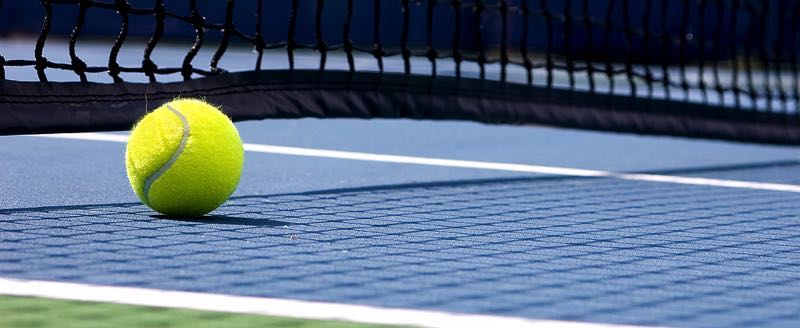Anyone who has ever played a game of tennis, or even just watched one taking place, will know that it is an incredibly physical sport. The biggest difference between tennis and boxing is that you actively hit each other when boxing, whereas if that happens in tennis then it is nearly always a mistake. There is the same sense of overwhelming physicality involved in the sport, however, with players repeatedly trading blows.
Tennis can involve two people going head-to-head or four people playing each other in a doubles match, but whichever way round you organise it the principle is still the same: score more points and win more matches than the opposition. Tennis tournaments are amongst the most popular things to watch in the world, with those that are regularly successful in the sport soon becoming household names.
The Best Bookies for Tennis
There are so many bookmakers out there that it can sometimes be quite tricky to decide between them all. I only recommend trustworthy bookmakers that have been awarded a license from the UK Gambling Commission, so you can rest assured that any of the bookies I talk about on here are reliable. Even so, the choice can be overwhelming if you’re relatively new to the world of bookmaking. That’s why I’ve decided to write these guides, helping you narrow down the best bookmakers by the thing that matters most to the majority of punters – the sports that they cover.
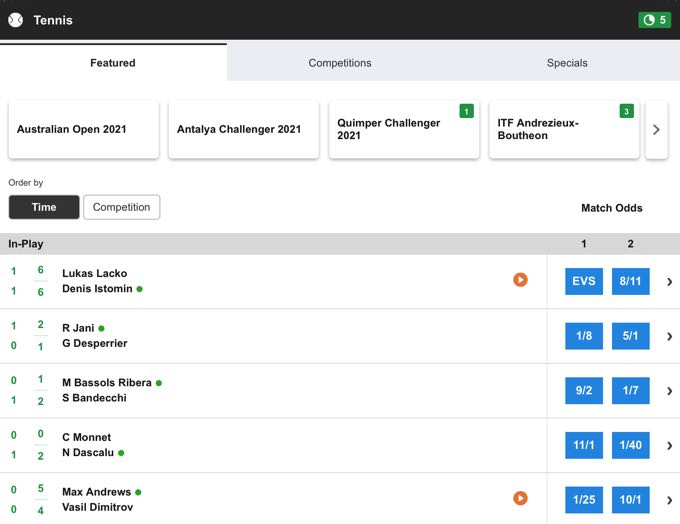
Betfair
Betfair are a brilliant company to bet on tennis with for one big reason - the Exchange. Though there are countless variations to the line-up in a tennis match (doubles, mixed doubles, singles etc), the essence of the sport is much the same as with any competitive thing, which is that it’s one side up against another. The ability to use Betfair’s Exchange to ‘Lay’ or ‘Back’ one competitor is perfect for tennis. If the Exchange isn’t something that you’ve managed to get your head around yet then don’t worry, Betfair’s sportsbook is as good as the best in the business and offers really competitive odds when it comes to tennis betting.
Don’t think that just because the Exchange is the company’s main site for driving traffic that the sportsbook won’t offer you the sort of features you’ve come to expect, either. They Live Stream most major matches and combine that with a ‘Live Statistics’ feature that works really well for tennis betting. You can both Cash Out and Partially Cash Out your bets, the latter of which is great for this particular sport. We’ve doubtless all seen matches where it looks as though one player is dead and buried only for them to surge back into it as it wears on. If you’d fully Cashed Out your bet in that game you’d be a wee bit disappointed, so hedging your bet by only Partially Cashing Out is ideal.
One of the big things that Betfair are good at doing when it comes to their tennis coverage is offers. Keep an eye out for various promotions going on, which change frequently. I do keep thinking back to the Exchange, though, mainly because that’s where you’ll want to head for some of the smaller games or tournaments. If you’re as keen to bet on a random doubles match from an International Tennis Federation tournament in Mexico as you on the outcome of a game at Roland-Garros then you’re unlikely to be disappointed with Betfair.
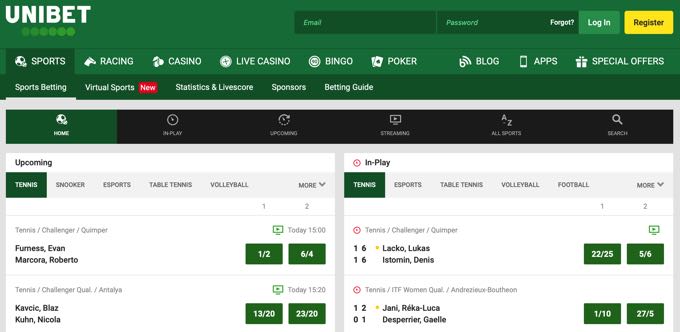
Unibet
Unibet have really begun to make a name for themselves over the last couple of years, getting involved in takeovers of company’s with good reputations in the United Kingdom. Though they’ve shown a determination to break in to the British market, there’s no denying that Unibet’s strength remains in the European market. That’s where they come in really handy when it comes to their tennis coverage, with countless smaller tournaments taking place across the continent on a regular basis and being covered with decent depth by Unibet.
The ATP Challenger Tour is a good example of what I’m talking about, with previous events taking place at venues such as the BNP Paribas Primrose Bordeaux in France, Braşov in Romania and the Country Time Club in Palermo, Italy. I’ve never struggled to get a bet on them via Unibet and more often than not even some of the smaller matches are Live Streamed on the company’s in-house streaming service. Within the individual match coverage you’ll find statistics that are really useful when you’re considering your bets, including how many games each player has won or lost on the different types of surface.
Their coverage of the smaller tournaments is good, but what they offer goes up a notch when the Grand Slams I mentioned in my introduction come about. That’s when tennis specific promotions kick-in and the likes of ball-by-ball action comes into play with their coverage. You can do all of the usual things such as Cash Out your bet, but it’s the depth of their coverage in combination with the exceptional odds that you can get that make Unibet a real must when it comes to your tennis betting.
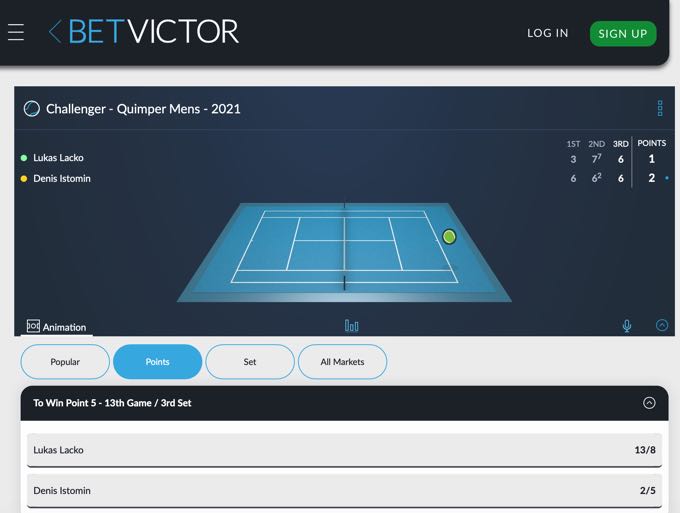
BetVictor
If you’ve read any of my other sports specific bookie recommendations then you’ll know that BetVictor are a real favourite of mine. Their coverage is genuinely excellent across the board, making them one of few Jack-of-all-trades bookmakers that are strong when it comes to pretty much every sport they offer. Their ante-post odds are great, but it’s when the tournament gets underway that they really come into their own. Their In-Play betting is really good, especially for the Grand Slams or big ATP matches.
The one big surprise when it comes to BetVictor and their tennis coverage is that they don’t offer Live Streaming. There’s a scoreboard that updates in almost real time and you can opt for Virtual Tennis if you’re really keen to see things pan out in front of you, but their lack of Live Streaming will be disappointing to some. Personally, I’m not that bothered, if for no other reason than I will often get my Live Stream from another bookie that I’m a customer of regardless of who I’m placing my actual bets with.
If you want to know if BetVictor will be offering In-Play betting or Cash Out on the match you want to bet on then keep an eye out on the symbol for each option within the individual match betting segment of the site. They’re introducing both of these features to more and more tournaments with each passing year, so don’t be surprised if even the lowliest event has it at some point in the future. BetVictor are also competitive when it comes to tennis-based promotions.
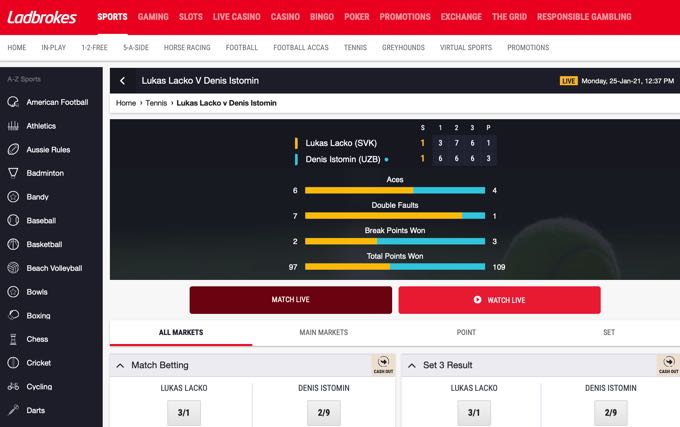
Ladbrokes
I’d be lying if I said I was a huge fan of the Ladbrokes website. I find the layout to be a little bit tricky to get my head around at times and it can definitely appear to be a bit more messy than I’d like. Even bearing that in mind, though, I wouldn’t hesitate to recommend Ladbrokes for their tennis coverage. As soon as you click on the link to the tennis section of their website you can tell that they mean business, with events broken down into ‘Today’s Tennis’, ‘Tomorrow’s Tennis’ and ‘Future Tennis’.
If those categories don’t tickle your fancy then you can look along the top of the page to see what’s big at the time you’re looking to place your bet. Depending on when you’re on the site, you’ll find Quicklinks to the likes of Enhanced Multiples, The NITTO ATP World Tour, the Toyota Challenger event and matches from the Taipei OEC Open. That will give you some indication of the depth of coverage offered by Ladbrokes that I find so appealing. This isn’t a bookmaker that tends to mess around when it comes to the big sports, so you’re extremely unlikely to be disappointed by what you find when login to your account.
A click into an actual live event will reveal a host of In-Play markets that you’ll want to give some serious consideration to. I’m talking about the likes of who will win individual matches, which way the sets will go and how many games there’ll be in total. You can Cash Out most of your bets and you’ll also be able to Live Stream a decent chunk of matches. If you want to watch stuff live online then all you need to is make sure that you’ve got money in your account or you’ve placed a bet within the last twenty-four hours. Ladbrokes also have an Exchange that you can turn to if the sportsbook isn’t giving you the sort of odds that you were hoping for.
Betting on Tennis
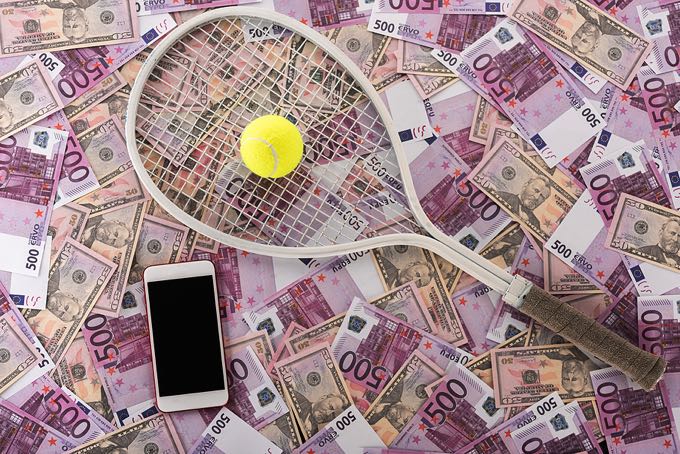
The beauty of tennis as a sport is that it can be played by virtually anyone. As long as you can hold a tennis racket you can play, which probably explains why it’s so popular with so many sections of society. Unlike something such as rugby or football, sports that require you to have particular physical attributes to be successful, tennis is really about little more than your hand-to-eye coordination and your physical dexterity. The nature of the game means that it’s one of the most popular sports for disabled athletes, with wheelchair tennis gaining in popularity with each passing year.
An Olympic sport that was founded in Birmingham in the nineteenth century, the simplicity of the game means that little has changed in its rules since its invention. The only major change being the introduction of the tiebreak in the 1970s. In more recent years, the game has been a fast adopter of technology, particularly with the use of the electronic review technology known as Hawk-Eye. Obviously, that hasn’t been able to filter down to the grass roots level just yet, but it has made the senior game much fairer and has had an affect on the way bets are won or lost.
There are four major Grand Slam tournaments in tennis, namely the Australian Open, the French Open, the US Open and Wimbledon. Each Grand Slam is played on a different surface, which is something I’ll refer back to later on when talking about how to bet on tennis matches. These tournaments make tennis a popular sport for spectators and it’s often fun to head down to the local park during the Wimbledon fortnight to see how many locals have been inspired to get their racket out of the cupboard and wipe the dust off it. This ability for anyone to play is probably also why so many people enjoy betting on tennis matches, with many feeling as though they can get to grips with the likely outcome of a sport they can play but are never likely to master.
How to Bet on Tennis
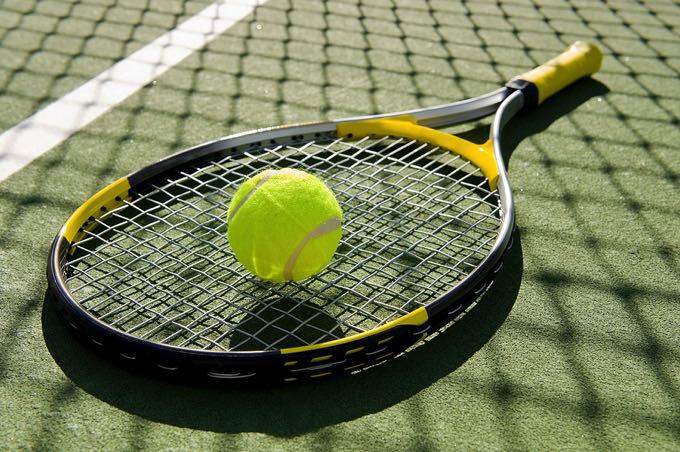
If you’re a long-term bettor then this section of the page may well feel a little like teaching grandma to suck eggs. However, I’m acutely aware of the fact that several people tend to find sites like this precisely because they don’t bet very much and so I’ve come up with a few hints and tips about the sort of markets you’ll want to look for when you start betting on tennis matches.
Tournament Betting
This is the tennis equivalent of betting on the winner of the Premier League or the Rugby World Cup. It’s an ante-post bet that you’ll place ahead of the start of a tournament before a ball has been tossed a racket has been strung. Provided the bookmaker you’re betting with knows their stuff, you’ll be able to place this sort of bet on any major tournament. Obviously all of the Grand Slams are popular, with Wimbledon one of the most bet upon tennis meetings across the year in the UK. Don’t forget the likes of the ATP Tour, though, nor the WTA Tour or the Challenger Tour that I mentioned earlier.
Ante-post betting always involves something of a risk, but that’s why you get longer odds than if you leave your bet until the tournament has started and you’ve been able to get more of a sense of what sort of form individual players are demonstrating. What I would say is that it’s vitally important that you don’t just go with the favourites for the tournament according to the press. Are any of them nursing injuries? Have some performed poorly in this competition before? Conversely, does anyone have a particularly good record at one venue over another? Ahead of Wimbledon in 2017, for example, not many pundits thought 35-year-old Roger Federer would stand much chance. He went on to win it for a record eighth time.
Match Betting
Match betting is the easiest type of bet to place on a tennis match. That’s because it’s a binary choice: who will win? Player X or Player Y? If it’s a doubles match then you’re obviously going to be betting on the pairing that you think will win, but the same rules apply. Unlike in plenty of other sports, there can’t be a draw in typical tennis matches. They’re normally played in a ‘best of three’ or a ‘best of five’ scenario, meaning that someone has to be declared the winner at the end it all. That actually makes match betting easier, simply because it removes one possible variation on the result.
The beauty of tennis is that players tend to play each on a fairly regular basis, especially when you’re looking at the top end of the form table. That means that there is heaps of information available to anyone that wants to do a bit of research before the match gets underway. Have the players gone head-to-head in this tournament before? When they’ve won or lost, has it tended to be on one surface over another, or in one country more than another? This info is readily available, so make sure you find out what you can and play the odds when you’re placing your match bets.
Set Betting
The problem with Match Betting is that the binary nature of the wager means that odds aren’t always as good as you might hope. Bookmakers will do the research I’ve told you to do, so you’re unlikely to find exceptional odds on a decent player unless they’ve made a mistake. One way to lengthen your odds a wee bit is to bet on something more specific, with Set Betting being one of the key ways of doing just that. This can take several forms, including the football scoreline equivalent of how many sets will the winners win by?
Another popular form of Set Betting is to opt for the Over/Under market. More often than not, men will play best of five and women will play best of three. That’s not always the case, so make sure you know the rules for the tournament you’re betting on ahead of time. If you’re betting on women’s tennis, therefore, you’ll normally have the option to bet Over/Under 2.5 sets, whilst the option in the men’s game will be Over/Under 3.5. A ‘straight sets’ win on women’s tennis will finish 2-0, meaning there were Under 2.5 sets played. If it’s a ‘five set thriller’ in a men’s match, however, that will mean it finished 3-2 and was Over 3.5 sets.
Handicap Betting
Speaking of giving yourself longer odds, a really good way of doing that is by opting for Handicap Betting. Handicap Betting is when the bookmaker gives one player a negative score in games or sets before the match has even begun or, alternatively, gives another player an advantage. You can usually place handicap bets on both Total Games and Set Betting. Depending on which one you’ve opted for, the rules will be slightly different:
Games Handicap Betting
When you place a handicap bet on the games then it’s important to bear in mind that most bookies consider this to be the total number of games played across the course of the match. Say you’ve placed a bet on Rafa Nadal to beat Andy Murray and you’ve applied a six game handicap to the Spaniard. This bet means that you think Nadal will win the match by more than a six game margin over the Scot. Say the match finishes 6-2, 6-1, 6-2 to Nadal, he’ll have won eighteen games compared to Murray’s five, meaning a margin of thirteen. Take the six games of the handicap away and that’s a seven-six win and you’re bet will pay off.
If, on the other hand, the match finishes 6-4, 6-2, 6-7, 6-4, Nadal will have won twenty-four matches and Murray will have won seventeen. Twenty-four minus six is eighteen, meaning Nadal has only won by one match and your six game handicap bet will have been a loser. It can be slightly confusing, but just remember to add up all of the matches each player has won and that will let you know whether your bet’s a winner or not. Again, your research will come in handy here as it will tell you whether or not one player has tended to win big against another in the past.
Set Handicap Betting
This can also be a little bit complicated, but you’re essentially giving one player a handicap and asking them to win in spite of it. Let’s say that you’ve placed a bet on Garbiñe Muguruza to win her match against Johanna Konta with a -1.5 handicap. That essentially means that you think the Spaniard will win the match by two sets to love, thanks to the fact that you’ll take 1.5 sets off her final score. A 2-0 victory, therefore, would be 0.5-0 once the handicap has been applied.
You can also choose to give a positive score to one player rather than a negative to the other. Sticking with the same example, you might choose to bet on Konta with a +1.5 wager. That means that you think she’ll win at least one set, so even if she still went on to lose the match you’ll have been victorious in your bet thanks to the end scoreline being 2-2.5 once the handicap has been applied. Whether you’re opting for Game or Set Handicap Betting, you can actually still win your bet even if the player themselves loses the match. That’s part of why it’s so popular.
Rules to Be Aware Of

Bookmakers always try to make their bets seem appealing, which makes total sense. After all, if you were running your own business you wouldn’t put all of the incidental small print on the advert. That’s why I decided to make a note of the most obvious rules that you should be aware of.
Retirement
No, I’m not talking about when a player decides to hang up their racket for good and become a commentator. ‘Retirement’ refers to when a player can’t finish a match because of injury or some other reason. In bookmaking terms it’s also used as a sort of catch-all phrase for when a match is never completed because of something like abandonment. One thing I should point out is that not all bookmakers apply the same rules, so you should consider this me drawing your attention to the issue rather than a hard and fast rule that will definitely be applied if a player you’ve bet on retires from a match.
Retirement can happen at any time of year and in any tournament, though you’ll probably find that it’s far more common in a random tournament in the middle of the year, when there’s not a huge amount to play for, than it is during one of the Grand Slams like Wimbledon, when a player will do anything they can to progress as far as possible. The different positions that bookmakers take up when it comes to judging bets on matches with retirements in basically depend on how much of the match needs to be played before they’ll pay out. Here are the typical options that bookies will choose between:
- One Ball Served – As long as one ball has been served, the bets will be paid out
- One Set Completed – You’ll need for a full set to be completed for bets to stand
- Whole Match Completed – Sadly, you’ll need the entire match to finish for your bets to be paid out
The rules don’t necessarily apply if a player is disqualified, but in terms of retirement or matches being abandoned they will normally kick-in. Please do make sure you find out what your favourite bookmaker opts for in this department. It can be an absolute killer if you think your bet is a winner, only to find out that the bookie you’ve gone with applies a Whole Match Must Be Completed ruling on retirements.
Tie-Breaks
The tie-break is an important part of tennis matches and can be quite thrilling, with players battling it out in the tensest of conditions to find out who’ll be declared the winner of a particular set. Sadly, they’re not quite as thrilling for bettors, with different bookmakers applying different rulings when it comes to tie-breaks. You can bet on things like ‘Tie-Break In First Set’ or ‘Tie Break In Match’, which are normally easy to know whether you’ve won your bet as they’re binary; which is to say there either was a tie-break or there wasn’t.
If the match is abandoned then those two types bets will be made void, unless the first set reached 6-6, in which case the bet will be declared as a ‘yes’. Equally, if the match reached the final set of a Wimbledon match before being abandoned and there hadn’t been a tie-break before that point then the ‘Tie-Break In Match bet will be declared a ‘no’, because the final set at Wimbledon never goes to a tie-break.
Impact of Court Surfaces on Betting

One of the biggest differences from one tournament to the next is the surface that matches are played on. The Grand Slams are unique because of their surfaces, with Wimbledon played out on grass, the US and Australian Opens taking place on hard courts and the French Open having red clay courts. Different players tend to favour playing on one type of court over another, so this is absolutely something you should think about ands research when you’re coming to place your bets.
I mentioned earlier that most of the information you’ll need is readily available for you and this the perfect example of what I’m talking about. Hard courts are typically much harder than the likes of grass courts, meaning the play is a lot quicker and the ball can bounce much higher. Clay courts are typically a lot slower than hard courts, though the ball can still bounce quite high. These courts are favoured by players who enjoy using a lot of spin in their shots. Grass courts, meanwhile, are often slower than the alternatives, with the ball tending not to bounce very high. They can often be slippery and uneven, meaning the flight of the ball can be far more unpredictable. Serve-and-volley players tend to do better on grass than other surface types.
Significantly fewer tournaments are played on grass than the other surfaces, with hard courts the most used surface type in the tennis world. When you’re looking at the stats of how one player has performed when up against another it’s crucial that you remember to investigate the type of surface that the players have played on. You might look and see that Player X has beaten Player Y twelve times and only lost three times, but all three of the losses and none of the victories may have been on clay. That will give you a clue about which way the match-up will go.

